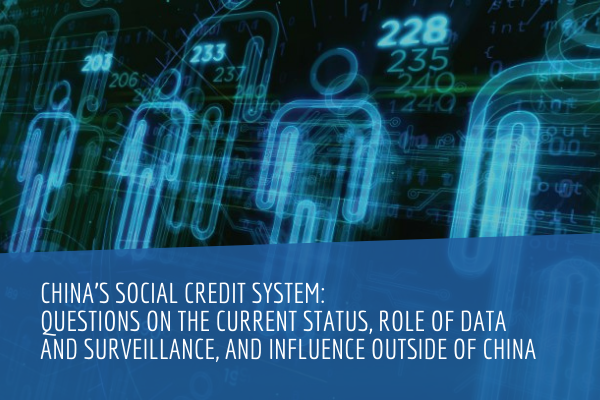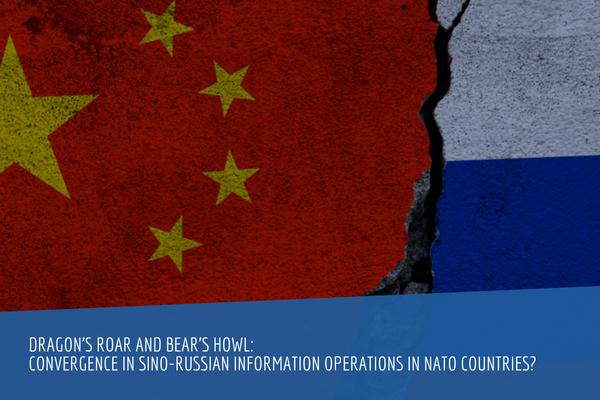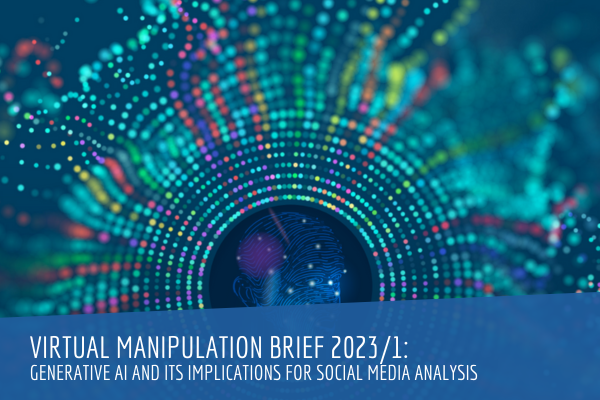Introduction
China’s Social Credit System (SCS) is a multifaceted project introduced by the Chinese government to:
- build trust in governmental, social, judicial, and corporate affairs;
- stimulate development in various areas, including the ‘socialist market economy’; and
- engender social governance and harmony.[1]
The SCS has attracted significant attention in recent years, and the complexity and uncertainties of the system have led to confusion on what it entails. Despite the singularity hinted at by the term, the SCS encompasses multiple systems, including those managed by government authorities and private companies. The full working paper explores the SCS via three questions:
- How far is the SCS from being a smoothly operating, holistic, and complete system?
- What is the role of data and surveillance practices in the operation of the SCS?
- What influence might the SCS have outside of China?
The deliberation of these three questions is the culmination of a literature review on the SCS, with a particular focus on the three questions above, and interviews with ten experts who have explored the SCS from various dimensions, including law, security, economy, and the use of technology in governance.
How far is the Social Credit System form being complete?
Per the literature review and interviewee accounts, the SCS is not a smoothly running, holistic mechanism, as of the writing of this working paper. It is a work-in-progress that is fragmented between the local and central governments regarding the interpretation of policies and implementation of SCS pilots in different localities. In addition, there are also social credit systems run by private companies, and collaboration between the government and private companies in this regard is a question debated by scholars and analysts. Various uncertainties plague this debate, especially those in the areas concerning data and information exchange. Further, data sharing, collaboration, and bureaucracy-related issues raise questions on the current and future trajectory of SCS.
The role of data and surveillance practices in the operation of the SCS
Matters of data management and analysis involve questions on data sharing, privacy, and security. Regarding surveillance, some see SCS as an addition to China’s surveillance capacity, while others suggest surveillance is a broader issue that intersects with the SCS, particularly in the area of law enforcement. The discussions covered in this chapter often stretch beyond the scope of the SCS and with that demonstrate the challenges to carving the SCS out of the broad and complex deliberation and concerns on data management/analysis and surveillance. The paper delivers various important insights on (1) data management and analysis and (2) surveillance, summarised below:
Data Management and Analysis: The debates concerning data management and analysis capabilities—including questions concerning data sharing, privacy and security—do not depict a system that is at the peak of automation and predictive analysis, and one that is guarded against privacy and security constraints. While there are developments on the data sharing, privacy, security, and analysis fronts, challenges remain, some of which expose risks and vulnerabilities. However, this does not mean that there is no room for development, and thus the areas identified in this research call for close observation.
Data Sharing: There have been advancements on data and information sharing capabilities among government bodies. However, as per the interviews and literature, there are data[2], technological capacity, and regulation-related disparities, as well as differences in conditions and practices at the local level. Regarding the data sharing between the government and corporations, and among companies with SCS schemes, interviews suggest that it is essential to differentiate between four information flows in question: (i) commercial credit programmes making use of government information (e.g., blacklists); (ii) companies sharing law-breaking behaviour occurring on their platforms; (iii) sharing social credit scores of users; and (iv) companies sharing SCS-related data on users. The degree of information and data exchange between the government and companies is a debated issue that raises more questions than answers.
Data Privacy: In the literature, some see an increase in citizen attention to data privacy issues,[3] some suggest citizens attribute different levels of trust to different government authorities with handling their personal data,[4] and some argue that the concerns about the risk of exploitation of data by companies fall behind worries such as government surveillance and prioritisation of their own interests.[5] Interview accounts had parallels with the literature while some interviewees also noted contextual differences in the concept and expectations of privacy. Issues, including the variance in privacy policies at local and national levels, worries about the data privacy of foreign entities and individuals engaging with China, and the risk of online privacy violations (e.g., identity theft) targeting the SCS, are likely to remain relevant in the near future.
Data Security: The risks raised in the literature and by interviewees in this regard include hacking, identity theft, ease in accessing personal data and the risk of manipulation of SCS-related data, which could amplify as the SCS evolves and more data get accumulated and linked.[6] The discussions on security problems, including cybercrime and threat of intrusion, concern how existing problems could spillover to the SCS.
Data Analysis: In the literature, some suggest that the national SCS is not at the level of a system that could pursue automated decision-making,[7] while others, including some who believe the SCS is currently not at that point, see a more technologically advanced system as a future possibility.[8] The interviewees question current abilities, with some suggesting companies are better equipped than the government on this front. Data nature (e.g., what is included and excluded in SCS data sets) and data quality (e.g., data richness, variance in data quality across localities, and difficulty of maintaining data quality) are some issues raised by interviewees that could also inform data analysis capacity. In addition, the impediments to data sharing, including the questions concerning infrastructure and willingness to share, could also arise as issues. Problems with using algorithms and the question of automated scoring also appear in discussions.
Surveillance: Some interviewees and literature warn against conflating the SCS and surveillance, some see it as an addition to China’s surveillance toolkit, and some expand on the intersections, especially in the area of law enforcement.[9] The existence of surveillance technologies in a global supply chain finds voice in some interviewee accounts. China’s growing surveillance capacity, and the extent of surveillance practice in China hint at contextual concerns with regard to the employment of surveillance technologies. More importantly, discussions of the interviewees suggest surveillance is a broader issue that is more concerning than the SCS.
Influence the SCS might have outside of China
The debates in the literature and accounts of interviewees on the potential reach of the SCS outside of China mostly see exact duplication of the SCS in other countries as an unlikely option. However, some question the various routes through which the SCS could influence or cause concern among other countries and non-Chinese entities, with several reservations that are outlined in the working paper. These potential avenues for influence include influence via and over companies (foreign and Chinese); influence over individuals (e.g., foreigners in China and diaspora); channels of influence that intersect with, yet cannot be reduced to, the SCS, including the export of surveillance technology and influence of artificial intelligence (AI) and data-related practices. There are also scholars, analysts and interviewees who warn of the rise of the SCS, or technologically-advanced authoritarianism, as a model that other countries, particularly authoritarian-leaning ones, could imitate.[10] The accounts of some interviewees hint at underlying concerns around the global dynamics of capitalism, surveillance —more importantly, the repressive use of related technologies— and China’s legal and political system. Existence of similar credit or ranking systems in different countries and the question of what sets the SCS apart emerge as part of this discussion.
Considerations for policymakers should take into account
In light of the learnings received from the literature review and interviews, it is essential to keep informed and watch developments in areas of concern, including the legal framework governing SCS, and evolution of the Social Credit System in China. Another critical area in need of observation is China’s policymaking process – how national policies are interpreted at local levels, thus, possibly, influencing the national Social Credit System model.[11] It is also necessary to observe, raise awareness, and consider norms around data and surveillance practices that expand beyond the scope of the Social Credit System.
Raising awareness alone might not be of help in environments where there is less opportunity for citizens and independent organisations to challenge the questionable practices of states and companies, and where certain surveillance and predictive analysis practices are carried out in secrecy.[12]
It is necessary to address various underlying concerns, chiefly the global surveillance market, data-related practices, and worries stemming from China’s legal and political system.
It is vital to be vocal and raise awareness on repressive uses of surveillance technologies and data practices. While doing so, countries have to reflect on the availability and use of such technologies within their own context.
As the competition to set standards in fields such as AI becomes heated, it is essential to agree on norms that propagate the use of related technologies for the benefit of society and prevent their use for repressive purposes. This requires the definition of the acceptable and unacceptable use of these technologies and reflection on domestic practices within one’s own context, being vocal on the use of such technologies in a repressive way, and strengthening cooperation to create and propagate human-rights-centric norms.
Here, a challenge lies in negotiating the needs for, and restrictions to, the use of these technologies with regard to their employment for governance and safeguarding national security. Agreement on norms in the international arena could also face the impediment of negotiating different needs and viewpoints of nations, and, if agreed, how norms could be effectively enforced might emerge as a question.
The discussions on underlying concerns raise the question of the interaction between freedom of expression, information pollution, the collective good, and surveillance in different political systems. The political system and the degree of oversight on the practices of surveillance and credit scoring is an area that calls for further research, especially at a time when approaches to monitoring the population during the COVID-19 pandemic are in the spotlight.
As an interviewee suggested, the adoption of a system similar to the Social Credit System is a political decision. This hints at the need for a healthy process of checks and balances, a venue for citizens to raise their concerns, and decision-making mechanisms that uphold human rights.
Conclusion
The Social Credit System is an evolving project, with developments and challenges occurring simultaneously in the areas of data management and data analysis, as well as surveillance. It is vital to stay informed and keep an eye out for any developments in the areas of concern regarding the Social Credit System, including the Social Credit System -related legislation(s), the use of surveillance technologies, and data policies.
Moving forward, the conditions that might have an influence on perspectives on and approaches to the Social Credit System include —but are not limited to— the rivalry between the US and China, especially in the area of technology and a growing use of surveillance technologies and the market around it.
This study involved semi-structured interviews with ten experts conducted between March 2020 and early July 2020. The researcher selected the interviewees based on their work on, or related to, the social credit system.
[1] Rogier Creemers, (eds.), ‘Planning Outline for the Construction of a Social Credit System (2014-2020),’ China Copyright Media: The law and policy of media in China, 14 June 2014
[2] Examples shared by interviewees include kinds of data collected, data quality, amount of data on localities in Credit China.
[3] Kostka, 2019. Liang et al., 2018, p. 434.
[4] As Kostka’s study (2019) revealed, citizens trust different government bodies at varying degrees in managing their personal data. The central government receives high trust (77%) while provincial governments (48%), municipal governments (42%), and state-owned companies (24%) rank lower, and private companies fall behind (8%) (Kostka 2019, p. 1587). The study of Rieger et al. (2020), on the other hand, suggested that some individuals are more concerned about issues such as government surveillance and prioritisation of government interest than potential exploitation of data by private companies (Rieger, Wang, and Ohlberg, 2020, pp. 2, 4). Kostka, ‘China’s Social Credit System and Public Opinion,’ 2019, 1587. Rieger, M. O., Wang, M., & Ohlberg, M., ‘What do young Chinese think about Social Credit? It’s Complicated,’ Berlin: Mercator Institute for China Studies, 2020, p. 2, 4.
[5] Rieger, Wang and Ohlberg, 2020, p. 2, 4.
[6] The literature discusses concerns about potential security breaches and hacking (Horsley, 19 November 2018; Chorzempa et. Al., 2018, p. 9; Arsène, 2018), how an increase in the connection of SCS-related databases could elevate the cost of hacking (Chorzempa et. Al., 2018, p. 9), how corporate SCS schemes also face the risk (Horsley, 19 November 2018; Zhang, 12 June 2019), and references to the black market for services offering credit manipulation or ways to eschew punishment (Ahmed, 24 January 2017; Chorzempa et. Al., 2018; Yew, 18 November 2018).
[7] Dev Lewis, ‘All Carrots and No Sticks: A Case Study on Social Credit Scores in Xiamen and Fuzhou,’ Medium, October 2019. See also Y.-J Chen, Lin, C.-F., & Liu, H.-W., 2018, p. 5. See Rogier Creemers, in Wright and Yager (eds.), December 2018, p. 123.
[8] Samantha Hoffman, ‘Social credit Technology-enhanced authoritarian control with global consequences,’, 2018. See also Y.-J Chen, Lin, C.-F., & Liu, H.-W., 2018, p. 1, 3, 5.
[9] Some of the examples from the literature include the following: Jeremy Daum argues that the SCS is ‘not coextensive with China’s surveillance apparatus’ (166). Kendra Schaefer argues that the ‘facial recognition, and remote sensing and social media and [...] other stuff connect’ to SCS ‘very tangentially’ Schaefer in ‘Demystifying China’s Social Credit System’ [Webinar by Asia Society], 1 December 2020). Hoffman (2017) suggests that the progress in AI and ‘surveillance state are all noteworthy on their own’, while the SCS ‘explicitly links them as parts of a broader political control process known as “social management”’(Hoffman, December 2018, p. 42) Liang et al. (2018), on the other hand, approach surveillance from the data aspect, which could facilitate the monitoring of the population, entities, and government bodies, and argue that currently there is more emphasis on ‘financial and commercial activities rather than political ones (Liang et. Al., 2018, p. 415). Interviewee accounts showed parallels with the literature while multiple interviewees expanded on the intersection or interaction in the areas of law enforcement.
[10] Some in the literature mention SCS’s potential ‘inspiration’ to other countries as a possibility. See Martin Chorzempa, Paul Triolo and Samm Sacks, ‘China’s Social Credit System: A Mark of Progress or a Threat to Privacy?,’ Peterson Institute for International Economics, Policy Brief 18-14, June 2018, p. 9. See also Mirjam Meissner in in A China File Conversation, ‘Is Big Data Increasing Beijing’s Capacity for Control?’ 10 August 2016. See also Yau Tsz Yan, Exporting China’s Social Credit System to Central Asia, The Diplomat, 17 January 2020.
[11] As per an interviewee’s detailed account on the policy making process and the importance of understanding it.
[12] The argument on secrecy emerged during a conversation with M. F. Bin Abdul Rahman.
References
Ahmed, S. (December 2018). Chapter 7. Credit Cities and the Limits of the Social Credit System. In Nicholas D. Wright and Mariah C. Yager (eds.) AI, China, Russia, and the Global Order: Technological, Political, Global, and Creative Perspectives, A Strategic Multilayer Assessment (SMA) Periodic Publication. December 2018.
Ahmed, S. (24 January 2017). Cashless Society, Cached Data: Security Considerations for a Chinese Social credit System. The Citizen Lab. 24
Arcesati,R. (29 January 2019). Chinese tech standards put the screws on European companies. MERICS.
Arsène, S. (2019). China’s Social Credit System: A Chimera with Real Claws. Paris: Institut Français des Relations Internationals.
Arsène, S. (2018). Trust in Ratings: China’s Social Credit System.
Baihang Credit (2020). Company Profile.
Banerjee, S. (2016). Aadhaar: Digital Inclusion and Public Services in India. 2016 World Development Report Background Paper: Digital Dividents.
Batke, J. and Ohlberg, M. (30 October 2020). State of Surveillance: Government. China File.
Blomberg, M. V. (2018). The Social Credit System and China’s Rule of Law. Mapping China Journal (2).
Brehm, S. and Loubere, N. (15 January 2018). China’s dystopian social credit system is a harbinger of the global age of the algorithm. The Conversation.
Brinkman, S. (2014). Unstructured and Semi-Structured Interviewing. In Patricia Leavy (eds), The Oxford Handbook of Qualitative Research, New York: Oxford University Press (2014).
Capri, A. (October 2020). Techno-nationalism and diplomacy: The Us- China race to reshape alliances, institutions and standards. Hinrich Foundation.
Chakravorti, B. (30 October 2020) 5 Questions about the Antitrust Case Against google That You should Not be Afraid to Ask. Foreign Policy.
China Law Translate (21 October 2020). Law of the People’s Republic of China on the Protection of Personal Information (Draft).
Cheang, M. (16 March 2017). FICO with Chinese characteristics: Nice rewards, but punishing penalties. CNBC.
Chen, Y.-J, Lin, C.-F., & Liu, H.-W. (2018), ‘Rule of Trust’: The Power and Perils of China’s Social Credit Megaproject. Columbia Journal of Asian Law, 32(1) 1-36.
Chen, Y. and Cheung, A.S. (2017). Transparent Self under Big Data Profiling: Privacy and Chinese Legislation on the Social Credit System. Journal of Comparative Law, 12(2). Doi: http://dx.doi.org/10.2139/ssrn.2992537.
China Law Translate (29 July 2020). Social Credit & the Law.
Chong, G. P. L.(2019). Cashless China: Securitization of everyday life through Alipay’s social credit system—Sesame Credit. Chinese Journal of Communication, 12:3. DOI: http://dx.doi.org/10.1080/17544750.2019.1583261
Chorzempa, M. , Triolo P. and Sacks, S. (June 2018). China’s Social Credit System: A Mark of Progress or a Threat to Privacy?. Peterson Institute for International Economics, Policy Brief 18-14, June 2018.
Credit China, 11 October 2019.
Creemers, R. (December 2018). Chapter 17: The International and Foreign Policy Impact of China’s AI and Big Data Strategies. In Nicholas D. Wright and Mariah C. Yager (eds.) AI, China, Russia, and the Global Order: Technological, Political, Global, and Creative Perspectives, A Strategic Multilayer Assessment (SMA) Periodic Publication, December 2018.
Creemers, R. (4 October 2018). Disrupting the Chinese State: New Actors and New Factors. Social Sciences Research Network.
Creemers, R. interviewed by Jacinta Keast (21 August 2018). The social credit system: China’s tool for moral education. MERICS Blog - European Voices on China.
Creemers, R. (22 May 2018). China’s Social Credit System: An Evolving Practice of Control. SSRN.
Creemers, R. (2017). ‘Cyber China: Upgrading Propaganda, Public Opinion Work and Social Management for the Twenty-First Century. Journal of Contemporary China, 26:103. http://dx.doi.org/10.1080 /10670564.2016.1206281
Creemers, R. in A China File Conversation (10 August 2016). Is Big Data Increasing Beijing’s Capacity for Control?
Creemers, R. (eds.) (14 June 2014). Planning Outline for the Construction of a Social Credit System (2014-2020). China Copyright Media: The law and policy of media in China.
Creemers, R. interviewed by Luchsinger, N. (n.d.). The Social Credit System – Part III,’ Asia Society Switzerland.
Crossley, P. K. (10 August 2016) in A China File Conversation. Is Big Data Increasing Beijing’s Capacity for Control?
Dai, X. (24 June 2018). Toward a Reputation State: The Social Credit System Project of China. Social Sciences Research Network.
Daum, J. L. (24 December 2017). China through a glass, darkly. China Law Translate.
Daum, J. L. in ‘Demystifying China’s Social Credit System’ [Webinar by Asia Society], 1 December 2020.
Daum, J. L. (21 March 2018). Who did China ban from flying? China Law Translate.
Devereaux, A. and Peng, L. (2020). Give us a little social credit: to design or to discover personal ratings in the era of Big Data. Journal of Institutional Economics, 16(3), 2020, 369-387. Doi: https://doi.org/10.1017/S1744137419000754
Engelmann, S., Fischer, F., Chen, M., Kao, C.-Y., & Grossklags, J. (2019). Clear Sanctions, Vague Rewards: How China’s Social Credit System Currently Defines ‘Good’ and ‘Bad’ Behavior. Conference on Fairness, Accountability, and Transparency, Atlanta.
Feldstein, F. (17 September 2019). The Global Expansion of AI Surveillance. The Carnegie Endowment for International Peace.
Forbrukerrådet (14 January 2020). Out of Control: How consumers are exploited by the online advertising industry.
Galletta, A. (2013). Mastering the Semi- Structured Interview and Beyond. New York and London: New York University Press.
Gan, N. (7 February 2019). The complex reality of China’s social credit system: hi-tech dystopian plot or low-key incentive scheme? SCMP.
Genia Kostka (2019). China’s Social Credit System and Public Opinion: Explaining High Levels of Approval. New Media and Society, 21(7). Doi:10.1177/1461444819826402
Haciyakupoglu, G. and Wu, S. (2019). China’s Social Credit System: Context, Impacts and Challenges. Conference paper presented at the International Studies Association Asia-Pacific Conference, 4-6 July 2019.
Hobbs, C. (July 2020). Project note: In search of Europe’s digital sovereignty,’ in Carla Hobbs (eds.), Europe’s Digital Sovereignty: From Rule Maker to Superpower in the Age of US-China Rivalry, July 2020.
Hoffman, S. interviewed by Mara Hvistendahl (19 August 2020). How China surveils the world. MIT Technology Review.
Hoffman, S. (May 16, 2019).China’s Tech-Enhanced Authoritarianism. In Testimony before the House Permanent Select Committee on Intelligence Hearing on “China’s Digital Authoritarianism: Surveillance, Influence, and Political Control”.
Hoffman, S. (2018). Social Credit Technology-enhanced authoritarian control with global consequences. ASPI Policy Brief Report No 6.
Hoffman, S. (December 2018). Chapter 6. Managing the State: Social Credit, Surveillance and the CCP’s Plan for China. In Nicholas D. Wright and Mariah C. Yager (eds.) AI, China, Russia, and the Global Order: Technological, Political, Global, and Creative Perspectives, A Strategic Multilayer Assessment (SMA) Periodic Publication, December 2018.
Hoffman, S. (17 August 2017). Managing the State: Social Credit, Surveillance and the CCP’s Plan for China. China Brief vol. 17, issue: 11 (The Jamestown Foundation).
Hoffman, S. (2017). Programming China: The Communist Party’s autonomic approach to managing state security. PhD thesis, University of Nottingham.
Hoffman, S. and Mattis, P. in A China File Conversation (10 August 2016). Is Big Data Increasing Beijing’s Capacity for Control?
Horne, F. (7 April 2014,). Ethiopia’s borderless cyberespionage. Human Rights Watch.
Horsley, J. P. (19 Novemver 2018). China’s Orwellian social credit score isn’t real. Brookings.
Human Rights Watch (26 February 2018). China: Big Data Fuels Crackdown in Minority Region.
Jain, M (9 May 2019). The Aadhaar Card: Cybersecurity Issues with India’s Biometric Experiment. The Henry M. Jackson School of International Studies, University of Washington.
Jayakumar, S. and Harjani, M. (21 October 2020). Between byte and bark — Singapore, US and Chinese tech. Today.
Jili, B. Chinese Social Credit Initiatives and African Surveillance States. Conference Paper.
Kostka, G. and Antoine, L. (28 July 2019). Fostering Model Citizenship: Behavioral Responses to China’s Emerging Social Credit Systems. Policy and Internet.
Koetse, M. (10 June 2018). Baihang and the Eight Personal Credit Programmes: A Credit Leap Forward. What’s on Weibo.
Leiden Asia Centre (24 February 2020). Report: China’s Social Credit System.
Leong, D and Teo, Yi-Ling (21 August 2020). Data Brokers: A Weak Link in National Security. The Diplomat.
Lewis, D. (October 2019). All Carrots and No Sticks: A Case Study on Social Credit Scores in Xiamen and Fuzhou. Medium.
Liang, F., Das, V., Kostyuk, N., and Hussain, M. M (2018). Constructing a Data‐Driven Society: China’s Social Credit System as a State Surveillance Infrastructure. Policy & Internet, 10(4). Doi: 10.1002/poi3.183.
Li, L. (April 2004). Political Trust in Rural China. Modern China 30, No 2.
Liao, R. (8 September 2020). China presents “global standard for data security. TechCrunch.
Liu, J. (2019). Is China’s social credit system really the dystopian sci-fi scenario that many fear? ThinkChina.dk Analysis.
Livingston, S. (October 2020). The Chinese Communist Party Targets the Private Sector. CSIS.
Loubere, N. and Brehm, S. (2018). The Global Age of Algorithm: Social Credit and the Financialisation of Governance in China. Made in China Yearbook 2018.
Lyngaas, S. (29 October 2020). Why the extortion of Vastaamo matters far beyond Finland – and how cyber pros are responding. Cyberscoop.
Mattis, P. (19 October 2012). China’s International Right to Speak. The Jamestown Foundation.
Meissner, M. (24 May 2017). China’s Social Credit System. MERICS.
Meissner, M. (10 August 2016) in in A China File Conversation. Is Big Data Increasing Beijing’s Capacity for Control?
Murrell, A. (31 July 2018). Pushing the Ethical Boundaries of Big Data: A Look At China’s Social Credit Scoring System. Forbes.
Ohlberg, M., Ahmed, S., and Lang, (2017). Central Planning Local Experiments: The complex implementation of China’s Social Credit System. Berlin: Mercator Institute for China Studies.
Paulo, D. A. (8 April 2019). Civilising China? A contentious social credit system moves boldly forward. Channel News Asia.
Pieke, F. N. (2012). The Communist Party and social management in China. China Information 26(2). DOI: 10.1177/0920203X12442864
Rahman, M. F. B. A. and Haciyakupoglu, G. (12 June 2020). Global Health Security: COVID-19 and Its Impacts – Pandemic, Technology and Privacy: How Far Will the State Go? RSIS Commentaries.
Rieger, M. O., Wang, M., & Ohlberg, M. (2020). What do young Chinese think about Social Credit? It’s Complicated. Berlin: Mercator Institute for China Studies.
Rushe, D. and Paul, K. (29 July 2020). “Too much power”: Congress grills top tech CEOs in combative anti-trust hearing. The Guardian.
Schaefer, K. (1 December 2020) in ‘Demystifying China’s Social Credit System’ [Webinar by Asia Society].
Schaefer, K. as cited in Jodi Xu Kelin (14 October 2019). Why US businesses should be worried about China’s corporate social credit system. SCMP.
Schaefer, K. (14 October 2019). The Apps of China’s Social Credit System. Trivium China.
Shapiro, J. (July 2020). Introduction: Europe’s digital sovereignty. In Carla Hobbs (eds.) Europe’s Digital Sovereignty: From Rule Maker to Superpower in the Age of US-China Rivalry, July 2020.
Síthigh, D. M. and Siems, M. (2019). The Chinese social credit system: A model for other countries? San Domenico di Fiesole, Italy: European University Institute.
South China Morning Post Internet Report 2020.
Tanner, M. S. (20 July 2017). ‘Beijing’s New National Intelligence Law: From Defense to Offense. Lawfare.
The European Chamber of Commerce in China and Sinolytics (2019). The Digital Hand: How China’ Corporate Social Credit System Conditions Market Actors.
The Guardian (26 October 2020). “Schoking” hack of psychotherapy records in Finland affects thousands.
The Straits Times (25 September 2019). ‘Alibaba buys a third of Jack Ma’s Ant Financial.’
Trivium China (September 2019). Understanding China’s Social Credit System: A big-picture look at social credit as it applies to citizens, businesses and government.
Wong, K. L. X. and Dobson, A. S. (2019). ‘We’re just data: Exploring china’s Social credit System in Relation to Digital Platform Ratings Cultures in Westernised Democracies. Global Media and China, vol4(2). DOI: 10.1177/2059436419856090
Wu, W. and Lee, A. (28 August 2019). China’s Social Credit System ‘could be used against companies in international trade disputes. SCMP.
Yan, Y. T. (17 January 2020). Exporting China’s Social Credit System to Central Asia. The Diplomat.
Yang, Y. and Liu, N. (19 September 2019). Alibaba and Tencent refuse to hand loans data to Beijing. Financial Times.
Yew, C. (18 November 2018 ). Commentary: Rating citizens - can China’s social credit system fix its trust deficit? Channel News Asia.
Zhang, Y. (12 June 2019). China to boost social credit system with new market regulatory measures. The State Council PRC.
Zuboff, S. (2019). The Age of Surveillance Capitalism: The Fight for a Human Future at the New Frontier of Power. Audiobook 2019.






